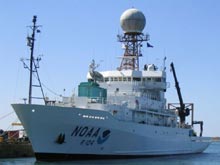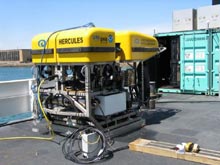Heading Out
May 8, 2004
Lance Arnold
Teacher
Tolland High School
Catalina Martinez
Office of Ocean Exploration
NOAA
The sigh of the shore follows in vain the breeze that hastens the ship across the sea.
— Rabindranath Tagore
The NOAA ship Ronald H. Brown embarked today on the Mountains in the Sea 2004 expedition. The 274-ft-long vessel carries crew, scientists, educators, and a highly skilled team of remotely operated vehicle (ROV) pilots and engineers. Recently, the Institute for Exploration (IFE) ![]() ROVs—Hercules and Little Hercules—were "refitted" for much deeper water than that for which they were previously rated. Now, for the first time, they will be tested at depth (about halfway through this cruise). The tools and associated components have been pressure tested in the lab. The pilots and engineers are confident that all will work well at sea, but the real test will not occur for several days.
ROVs—Hercules and Little Hercules—were "refitted" for much deeper water than that for which they were previously rated. Now, for the first time, they will be tested at depth (about halfway through this cruise). The tools and associated components have been pressure tested in the lab. The pilots and engineers are confident that all will work well at sea, but the real test will not occur for several days.
The success of our mission depends heavily on the high-tech IFE equipment, which was loaded on board in Woods Hole, Mass. IFE has developed a suite of vehicles and support technology for ocean exploration, and we will use the majority of these tools during the Mountains in the Sea cruise. This equipment includes a lighting and camera sled, Argus; an imaging ROV, Little Hercules; a larger imaging and excavating ROV, Hercules; a satellite tracking antenna; an enormous winch and wire; a tool van; shipping van; control/imaging van; and a satellite van.
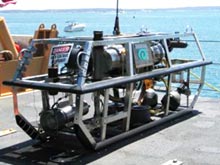
IFE’s light-bearing camera sled, Argus, on the deck of the NOAA ship Ronald H. Brown. Click image for larger view.
The light-bearing camera sled, Argus, is also the platform from which the "tether" is managed to the ROV. With propellers for maneuverability and a cable to the ship above, Argus will hover over the ROV, illuminating the deep and transmitting images to the banks of computers lined up in the ROV control vans on the ship. Scientists, graduate students, and educators will view the images on rows of plasma screens in the control van, science labs, and the bridge. Meanwhile, in an adjacent van, the ROV pilots, navigators, and engineers will control the underwater robotic tools via complex joysticks and computers. Headphones and an integrated audio system allow the scientists and ROV pilots to work as a team during the dives.
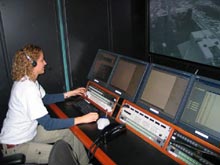
Graduate assistant Kari Heinonen, University of Connecticut, trains on the audio system in the IFE ROV control van. Click image for larger view.
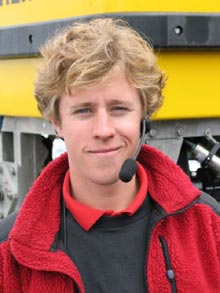
Twenty-six-year-old ROV pilot Todd Gregory, with degrees in naval architecture and ocean engineering, “flies” Hercules. Asked how he got the job of pilot, he answered: “I took part in the design and development of the Hercules ROV, and so now I get to drive it!” Seems fair. He has the enviable job of picking up amphoras in the Black Sea and deep-sea corals from mid-Atlantic seamounts. Soon, he will return to the Titanic with NOAA and National Geographic to assist with a degradation study of this historic site. What a life!
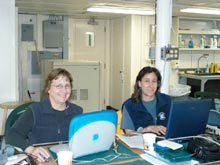
Diana Payne, Sea Grant education coordinator (right), and Mary Grady, adjunct Earth science instructor at Northeastern University, produce education/outreach materials. Click image for larger view.
We are steaming toward the New England Seamount Chain to learn more about deep-sea corals, fishes, and other organisms living on and around the seamounts. Scientists will study coral genetics and reproduction, larval dispersal, and commensal relationships between corals and other organisms, including the benthic (bottom-dwelling) fishes that make these undersea mountains their home. Scientists eagerly anticipate new findings and a more thorough understanding of these special ecosystems.
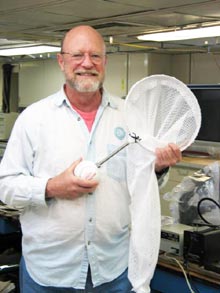
Lance Arnold, an educator from Tolland High School in Connecticut, constructed nets for Hercules. Note the softball attached to the end of the handle: it's a "gripper" for the ROV manipulator. Click image for larger view.
During transit, the science crew worked to set up "wet labs" (for dissection and processing of specimens) and "dry labs" (for photography), as well as computer work stations and areas for the development of sampling gear. The crew immediately put the educators to use. Lance Arnold, a biology and oceanography teacher from Tolland High School, constructed nets to be used by the ROV to collect fossilized corals (sometimes found in rubble piles on the sides of seamounts). He attached softballs to the end of the net handle, creating "grippers" for the ROV manipulators. Mary Grady, adjunct Earth science instructor at Northeastern University, worked with Diana Payne, Sea Grant education coordinator, writing logs and collecting digital images for the production of outreach/education materials.
We will spend our first night just outside the Woods Hole Harbor, waiting for a critical IFE team member who could not be on board in time for the safe departure of the Ronald H. Brown. In the morning, a small launch will pick him up, and we will then transit to our first dive site—Bear Seamount. Stay tuned for images of our first dive!
Sign up for the Ocean Explorer E-mail Update List.






















